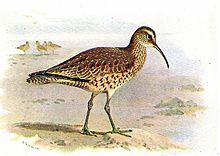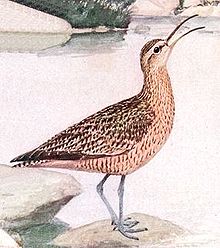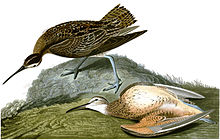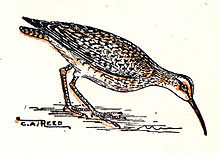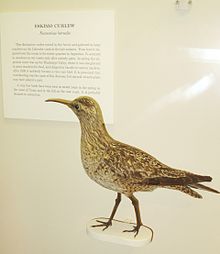- Eskimo Curlew
-
Eskimo Curlew 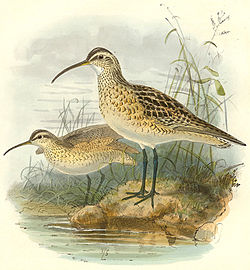
Lithograph by Henry Eeles Dresser Conservation status Scientific classification Kingdom: Animalia Phylum: Chordata Class: Aves Order: Charadriiformes Family: Scolopacidae Genus: Numenius Species: N. borealis Binomial name Numenius borealis
(Forster, 1772)The Eskimo or the "Northern Curlew" is a critically endangered shorebird, now considered by many to be extinct.
Contents
Taxonomy
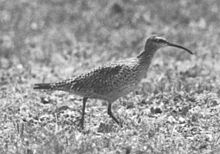 One of four known photographs of a living Eskimo Curlew, taken by Don Bleitz on Galveston Island in 1962
One of four known photographs of a living Eskimo Curlew, taken by Don Bleitz on Galveston Island in 1962
The Eskimo Curlew is one of eight species of curlew, and is classed with them in the genus Numenius. It was formerly placed in the separate genus Mesoscolopax.[1] Numenius is classed in the family Scolopacidae. Other species in that family include woodcocks, phalaropes, snipes, and sandpipers. Scolopacidae is a Charadriiform lineage.
The species was described by Johann Reinhold Forster in 1772.[2] The generic name has three possible etymologies. One is that it comes from the Greek "noumenios". "Noumenios" means "of the new moon", the curlews' thin beak being compared to a thin crescent moon.[3] A second possibility is that the genus name comes from the word numen, meaning "nod", and referring to this species head being bent forwards and down. The final possibility is that Numenius is a Latinized form of the Greek noumenios, which was the word Diogenes Laertius used to refer to a species of curlew. The specific name "borealis" is Latin for "northern".[4]
This species has many common names. It has been named the Prairie Pigeon, Fute, Little Curlew, Doe-bird, and Doughbird. These last two names come from its fatness during early migration south.[5]
Description
Eskimo Curlews are about 12 or 13 inches in length.[6] Adults have long dark greyish legs and a long bill curved slightly downwards. The upperparts are mottled brown and the underparts are light brown. They show cinnamon wing linings in flight. They are similar in appearance to the Hudsonian Curlew, the American subspecies of the Whimbrel, but smaller in size. In the field, the only certain way to distinguish the Eskimo Curlew are its unbarred undersides of the primaries (Townsend, 1933). The call is poorly understood, but includes clear whistling sounds.[7]
Eskimo Curlew formed a species pair with the Asian Little Curlew, Numenius minutus, but is slightly larger, longer-winged, shorter legged and warmer in plumage tone than its Asian relative.
Distribution and habitat
The Eskimo Curlew is a New World bird. Members of this species bred on the tundra of western arctic Canada and Alaska.
Eskimo Curlews migrated to the pampas of Argentina in the late summer and returned in February.[6] They were formerly very rare vagrants to western Europe, but there have been no recent records. In Britain, there are four records, all from the 19th Century.[8]
A comparison of dates and migratory patterns has led some to conjecture that Eskimo Curlews and American Golden-Plover are the shorebirds that attracted the attention of Christopher Columbus to nearby land after 65 days at sea and out of sight of land on his first voyage. In the 1800s millions of Eskimo Curlews followed migration routes from the present Yukon and Northwest Territories, flying east along the northern shore of Canada, then south over the Atlantic Ocean to South America in the winter. When returning to North America, they would fly north through the Great Plains.[9]
Ecology and behavior
Diet
Eskimo Curlews picked up food by sight, as well as feeding by probing. They ate mostly berries while on the fall migration in Canada. During the rest of their migration and on the breeding grounds they ate insects. Snails and other invertebrate were also part of their diet during migration.
Reproduction
Nesting probably occurred in June. Nests were located in open areas on the ground and are difficult to locate. They were made of wisps of dried grass or leaves. The eggs are green with brown splotches.[5]
This species' specific incubation behavior is unknown.[5] It is not certain which sex if not both incubated, and what the specific timeline was. These birds evidently did not attack intruders approaching their nests, which provides reason to believe that their nests were far apart from each other.[10]
Near extinction
At one time, the Eskimo Curlew may have been one of the most numerous shorebirds in North America with a population in the millions. As many as 2 million birds per year were killed near the end of the 19th century. The last confirmed sightings were in 1962 on Galveston Island, Texas (photographed) and on Barbados in 1963 (specimen). There was a reliable report of 23 birds in Texas in 1981, and more recent additional unconfirmed reports from Texas, Canada (1987), Argentina (1990), and Nova Scotia (2006). No confirmed record of this species has been reported in South America since 1939. Full details on all sightings up to 1986 are included in the on line edition of Eskimo Curlew: A Vanishing Species?
This species is fully protected in Argentina, the Brazil, Canada, the United States, and Mexico. Hunting has been outlawed since around 1916.
In popular culture
The plight of this bird inspired the novel (and subsequent Emmy Award winning 1972 ABC Afterschool Special) Last of the Curlews.
The Esquimaux Curlew (sic) appears as plate CCCLVII of Audubon's Birds of America.
In the 1950s the Eskimo Curlew was a subject of the Mark Trail comic strip by Ed Dodd and Tom Hill.
Notes
- ^ South American Classification Committee American Ornithologists' Union. "A classification of the bird species of South America Part 02". http://www.museum.lsu.edu/~remsen/SACCBaseline02.html. Retrieved 2008-01-12.
- ^ "Coraciiformes". http://www.zoonomen.net/avtax/frame.html. Retrieved 2007-12-21.
- ^ John K. Terres (1980). The Audubon Society Encyclopedia of North American Birds. pp. 769. ISBN 0-394-46651-9.
- ^ J.B. Gollop, T.W. Barry, & E.H. Iverson (1986). "A Curlew By Many Other Names". Eskimo Curlew A Vanishing Species?. Nature Saskatchewan. http://www.npwrc.usgs.gov/resource/birds/curlew/names.htm. Retrieved 2008-01-12.
- ^ a b c John K. Terres (1980). The Audubon Society Encyclopedia of North American Birds. pp. 776. ISBN 0-394-46651-9.
- ^ a b Ellis, Richard (2004). No Turning Back: The Life and Death of Animal Species. New York: Harper Perennial. pp. 178. ISBN 0-06-055804-0.
- ^ J.B. Gollop=1986, ed. Eskimo Curlew: A Vanishing Species?. Nature Saskatchewan Saskatchewan Natural History Society.
- ^ Melling, Tim (2010) The Eskimo Curlew in Britain British Birds 103(2): 80-92
- ^ Kenn Kaufman (1996). Lives of North American Birds. ISBN 0-395-77017-3.
- ^ J.B. Gollop, T.W. Barry, & E.H. Iverson (1986). "Life History -- Briefly Stated". Eskimo Curlew A Vanishing Species?. Nature Saskatchewan. http://www.npwrc.usgs.gov/resource/birds/curlew/history.htm. Retrieved 2008-01-12.
References
- IBAMA (2003). Lista das Espécies da Fauna Brasileira Ameaçadas de Extinção. Accessed 2010/07/14.
- BirdLife International (2004). Numenius borealis. 2006. IUCN Red List of Threatened Species. IUCN 2006. www.iucnredlist.org. Retrieved on 11 May 2006. Database entry includes a range map and justification for why this species is possibly extinct
- del Hoyo, J.; Elliott, A. & Sargatal, J. (editors) (1996): Handbook of Birds of the World, Volume 3: Hoatzin to auks. Lynx Edicions, Barcelona. ISBN 84-87334-22-9
- National Geographic Society (2002): Field Guide to the Birds of North America. National Geographic, Washington DC. ISBN 0-7922-6877-6
- Townsend, Charles W. (1933): Sight Records of the Eskimo Curlew. Auk 50(2): 214. PDF fulltext
External links
Categories:- IUCN Red List critically endangered species
- Curlews
- Numenius
Wikimedia Foundation. 2010.


